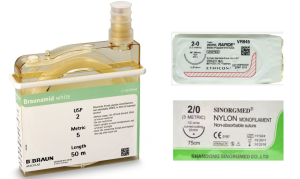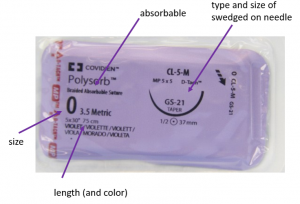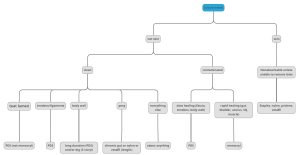General Surgery
Suture material
Choosing suture material can seem overwhelming at first. There are a myriad of suture types out there, all with different needles and packaging. However, most times, our choices are more limited.
Suture related factors
Absorbable or not absorbable
Absorbable suture materials are hydrolyzed by the body and dissolve over time. Absorbable suture is typically preferred when the sutures won’t be removed (eg inner layers of the skin or body). The body typically reacts to suture, seeing it as a foreign body. The problem is resolved as the suture is dissolved.
Nonabsorbable suture material is used externally (skin) and when maintained strength or security is essential (eg tendon replacement). Most of these are fairly inert so the foreign body reaction is minimal.
| Absorbable | Nonabsorbable |
|---|---|
| Vicryl
Polysorb Monocryl PDS Maxon Dexon Chromic gut |
Nylon
Prolene Vetafil Braunamid Stainless steel
|
Monofilament or braided
Monofilament sutures are single stranded. Such suture material tends to glide through tissue better than multifilament suture. However, monofilament sutures are more likely to fatigue and break. Braided suture is stronger but tends to wick (draw up) fluids. This can lead to infections when braided suture is used in contaminated environments.
Example of wicking using blue dye and rope.
Chromic gut is extruded. It is multifilament but not braided. However, the filaments are easily damaged and lead to a fraying and a rough surface that can potentiate infection similar to braided suture material. Because it is easily frayed, surgeon’s knots are not recommended when working with chromic gut.
| Monofilament | Braided (or frays) |
|---|---|
| Monocryl
Maxon PDS Nylon Prolene Staples Wire |
Vicryl
Polysorb Chromic gut Vetafil Braunamid |
Duration and strength of duration
The suture needs to last long enough for the tissues to heal. However, it shouldn’t last much longer than needed due to the foreign body reaction. Nonabsorbable suture materials last at least 6 months, by definition. Other suture materials vary in duration of relevant strength. In some instances, this is confounded by the environment. Eg Dexon dissolves rapidly in urine, monocryl in milk and many suture types in pus or infected fluids.
| Loses strength 10-14 days | Loses strength 14-28 days | Loses strength 1-2 mo | Maintains strength > 6 mo |
|---|---|---|---|
|
Monocryl Dexon |
Vicryl
Polysorb Chromic gut
|
PDS (5-6 weeks)
Maxon (4 weeks) |
Nylon
Prolene Vetafil Braunamid Stainless steel |
Reactivity
Some suture is minimally reactive (stainless steel) while other suture is highly reactive (Vetafil, chromic gut). In many instances, one or the other is preferred. If we would like to create an adhesion quickly, reactive material is typically good. Reactivity matters most in internal structures.
| Limited reactivity | Mildly reactive | Very reactive |
|---|---|---|
| Stainless steel
Nylon Prolene PDS Maxon |
Vicryl
Polysorb
|
Chromic gut
Vetafil Braunamid
|
Size availability
Not all suture is manufactured in all sizes. Suture sizes range from 9-0 and smaller (ophthalmological, vascular surgery, etc) to 5 Vetafil (cow hide). Veterinary suture typically ranges from 4-0 to 3 USP in general practice. Most come in the range of 3-0 to 0 and may go beyond that but it depends on the suture. Only polyglactin 910 (Vicryl) currently comes in size 3 USP (US version). European suture sizes use a different scale.
Packaging

Suture on reels (image on left) can be cut to a desired length but is sometimes only cold sterilized and may not be acceptable for all situations. Most other suture is packaged in smaller lengths. The suture may also be swedged (fused) onto a needle or be needle-less. The type of needle attached can also vary widely. Typically cutting needles are needed for skin and tough tissue; taper needles are safer for delicate tissues. Finding the right suture in the right length with the right needle on it can be challenging.
Vetafil, braunamid and chromic gut can come on reels or in packages of long lengths. Pretty much everything else comes in the little suture packets.
Price
Particularly due to the type of needle attached (and if a needle is attached), price can vary between manufacturers and suture sizes.
Surgeon preference
This category is typically called knot security or ease of use, but really each of us likes different suture material. If you are comfortable with a suture material, you use it more often and adjust to its quirks. Change is hard.

| Memory (like fishing line) | No memory (limp fish) |
|---|---|
| PDS
Maxon Nylon Prolene |
Vicryl
Polysorb Silk
|
Patient related factors
External or internal
Is the suturing taking place in the skin or elsewhere? Will it need to stay permanently? If skin, think non-absorbable. If internal, generally it is absorbable.
Duration of healing
How long will it take the tissue to heal? How long does the suture need to maintain strength? If it is going to heal quickly, suture that dissolves quickly is a better match than suture that stays for 6 months. If it is going to take months to heal, avoid vicryl, monocryl and chromic gut.
Forces on the tissue (strength)
How much force is typically on the tissue? How strong does the suture need to be? The suture needs to be as strong as the healthy tissue, when possible. More strength isn’t needed since the wound will also dehisce (fall apart) when the tissue tears even if the suture holds.
Risk of infection
Is the procedure clean, contaminated, or dirty? Is wicking an issue? Avoid braided and fraying suture if the area is contaminated or dirty.
Needle and suture length
What are the needs of the procedure? How big/small a needle is desired to get through the tissue? How delicate is the tissue? How long a section of suture is required? Note that sutures come in different lengths and with different size needles attached. You might be fine with 3-0 suture but not with the needle attached to it.
Making your own swedged on needle
Other factors
Are there other factors that will alter healing or suture function? Is it in the bladder, the teat or the tendon? Is milk, urine or pus potentially in contact with the suture? Are adhesions desired or something to be avoided? Remember some suture dissolves in urine and other in milk. Some sutures are reactive while some are more inert.
Suture choice flowchart-


